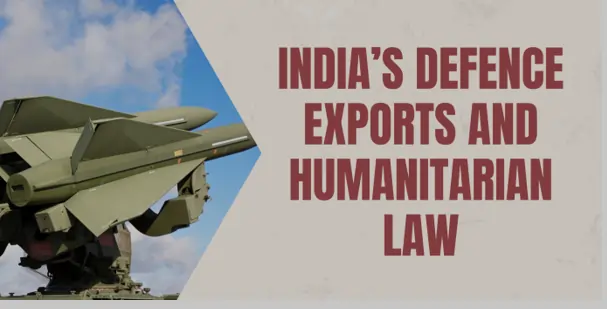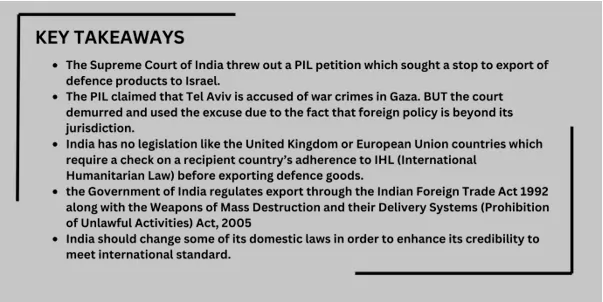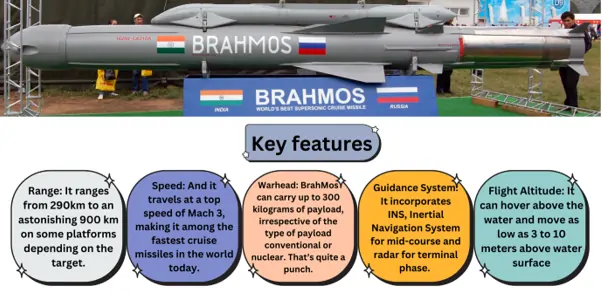
India Defence export is an important topic and through his article ‘India’s Defence Exports and Humanitarian Law,’ published on The Hindu on 24th September, 2024, Prabbash Ranjan has highlighted a significant problem. The Supreme Court of India threw out a PIL petition which sought a stop to export of defence products to Israel. The PIL claimed that Tel Aviv is accused of war crimes in Gaza. BUT the court demurred and used the excuse due to the fact that foreign policy is beyond its jurisdiction. But this matter is not confined to Israel – it is as much about India’s desire to be a major defence exporter.
Here are the key points from the article:
Legal Gap in Indian Law
India has no legislation like the United Kingdom or European Union countries which require a check on a recipient country’s adherence to IHL (International Humanitarian Law) before exporting defence goods. Although the Government of India regulates export through the Indian Foreign Trade Act 1992 along with the Weapons of Mass Destruction and their Delivery Systems (Prohibition of Unlawful Activities) Act, 2005 that does not contain specific provisions of IHL compliance. In other words, India’s domestic law doesn’t compel an evaluation of the possibility of recipient country using the exported equipment to offend IHL.
International Norms and Comparisons
Other countries on the other hand have chosen a different path. For instance:
The Netherlands court has urged the Dutch government to ban the shipment of ammunition components in F-35 fighter jets to Israel citing an EU regulation. The regulation in question allows the export of military equipment only provided that the country which intends to purchase the latter is unlikely to breach IHL.
The United Kingdom took stock of Israel’s comportment according to the IHL regarding the conflict in Gaza. That is the case of those arms exports to Israel which the production identified as constituting a clear risk of contributing to serious IHL violations.
India’s Strategic Leap
In this connection, the author suggested that India should change some of its domestic laws in order to enhance its credibility to meet international standard. Thus, adopting new legislation such as the U.K.’s Export Control Act or parts of the EU Common Position would guarantee reasonable arms exports. This kind of step will not only strengthen India’s profile as a defence exporter but will also affirm commitment to law of war.

In conclusion, the present article highlights the significance of the necessity of eradicating essential differences between legal and ethical standards in the sphere of defence exportation, as well as the should plug the gap by including the IHL compliance reviews to Indian defence export system. India specifically would stand to gain so much in terms of its credibility if it had such a comprehensive legislation enabling it to facilitate for a more responsible flow of arms in the international market.
(Source: The Hindu)
Balance between Strategic Interest and humanitarian concerns
In view of the fact that we now have anti-India raising their vicious head again, how does New Delhi accommodate humanitarian concerns about people in trouble in neighbouring countries is not there cup of tea.
India’s Strategic Interests
- Security and Stability: India has always been in a centre of many important powers of the world due to the location of the country. Being secured and stable is what matters most for it. This encompasses preserving a robust military force, external security, as well as dealing with threats posed by both governmental and non-governmental agents.
- Economic Growth and Trade: India aims at economic well-being through trade, investments and technology. It seeks to become a world-class partner in such areas as information technology, health, and production. To achieve these goals, strategic partnerships with other countries are therefore important.
- Regional Influence: India has regional hegemonic aspirations in South Asian region and Indian Ocean region. India uses negotiation and construction as well as promotion of cultural interaction to strengthen its capability like “ACT EAST POLICY”.
Humanitarian Concerns
- Refugee Crises: Cross border refugees finding their way into India include those fleeing conflict, persecution, and natural disasters in neighbouring countries. Security issues have to be addressed, yet there must be a large portion of concern for people.
- Climate Change and Disaster Relief: India being a climate change vulnerable country, deals with natural disasters. It has to meet the humanitarian requirement at the same time as it prevents or deals with the effects of climate change.
- Health and Poverty: Poverty is still a challenge for India despite this preserving people’s right and providing them with healthcare, education and other necessities remain a part of humanitarianism.
Strategies for Balance
- Multilateral Diplomacy: India is most reliable partner at all multilateral leaves whether it is UN or BRICS it always works for peace. On humanitarian causes it engages in partnerships while protecting its interests.
- Soft Power: India uses culture, yoga, and Bollywood to warm the hearts of people across the world. Soft power measures aptly can support strategic concerns.
- Development Assistance: The type of assistance offered by India is capacity development, including education and capacity for health besides technical cooperation. This is in line with humanitarian needs.
- Conflict Resolution: India contributes to peace keeping activities and conflict management processes. It ensures that it serves its strategic interests at the same time as it maintains stability and the prevention of any conflicts.
Therefore, the triangular diplomacy enunciated here is a stoic approach of making decisions without aggravating the scores between the optimists and skepticism regarding power shift, mentioning that, ‘strategic interest and humanitarian motivation need not be antagonistic.’ In this way, the country can tread on the thin line and maintain a positive impact on the world economy as well as on its own economy.
Current stance on defence exports
India has also changed its position on the export of defence products in recent years indicating that the nation is serious about the policy of preparing to be ready to defend itself with efficiency and intent about positioning itself as capable buyer and seller of weapons business. Let us examine the particulars:
Significant Expansion in Q1 FY 2024-25
Defence exports from India have shown a splendid performance on the increasing front. For the first quarter, April to June 2024 of the FY 2024-25, the export value registered a magnificent growth of 78 percent, touching ₹6,915 crore. This sort of expansion demonstrates specific commitments of India, on enhancing the procedure of indigenization of the defence industry and curbing imports.
Unprecedented Accomplishments
According to the Economic Survey 2023-24: Record defence exports in FY 2023-24 were approximately ₹20,915 crore. This was actually an increase of twenty-five percent compared to the previous financial year. Defence exports from India have risen more than twelve-time during FY 2017 making the country a new entrant in the global arms exporting countries.
Domestic manufacturing Surge
At the same time, the domestic defence manufacturing in India grew tremendously. Domestic production hit over ₹1.27T for FY 2024, though it was 16.7% higher compared to the last FY. Indeed, through the government drive to support local industry, the boom has been realized.
Ban on Imports and Indigenization
310 different weapons and systems have been subjected to a phased import ban in the last two years in India. This is intended to enhance export trade, through gradually domesticating these platforms over the period of the next five to six years. In fact increasing defence exports are collaborations with the commercial sector as well.
Strategic Leap and Global Presence
India is today among the twenty five largest arms exporters in the world that sell its defence equipment to about eighty five countries. This expansion has been supported by the high number of export authorizations issued in FY 2024 i.e. 1507 to defence manufacturers.
Specific defence products India export
India has managed to increase its stand in the international market by expanding its defence exports. Let’s dive into some of the major defence products that India exports:
Aircraft: Dornier-228
One of India’s main export successes is the Dornier-228, a versatile twin-turboprop aircraft. It does function informally in different capacities such as surveillance, transportation and maritime surveillance.
Artillery Guns
The Tatra-trucked 155 mm Advanced Towed Artillery Guns (ATAGs) are important for ground forces and are exported by India. These are guns that offer long range support and also flexibility in movements.
Missiles: BrahMos and PINAKA
The supersonic cruise missile called BrahMos developed jointly with Russia is one of the most reputed Indian exports. It’s well-recognized for both, precision and flexibility. Others are PINAKA rockets and launchers. These multiple rocket launch systems improve the artillery systems.
Radars and Simulators
Some of the radar systems exported by India are used for surveillance, tracking, and air defence. As part of export portfolio it also provides training simulators for pilots and other ground personnel.
Armoured Vehicles: Information products include mine protected vehicles and other armoured platforms for export. These are used during operations in protecting the military troops.
Personal Protective Gear: India supplies vests, helmets and other accoutrements worn by soldiers.
Surveillance Systems: Coastal based surveillance plays the role of enhancing maritime security and are required in every country.
BrahMos

Origin and Collaboration
The BrahMos is a missile produced by a collaboration of Indian DRDO and Russian NPO Mashinostroyeniya. They set up BrahMos Aerospace Limited in joint venture. The name “BrahMos” itself is a clever portmanteau, combining the names of two rivers: In India they include the Brahmaputra while in Russia include the Moskva.
Versatility and Platforms
This missile is a medium-range ramjet supersonic cruise missile that can be launched from various platforms:
- Submarines: It can come up from under the water with a vengeance.
- Ships: Naval vessels can also launch BrahMos.
- Fighter Aircraft: It can be carried to extreme macro levels such as being strapped to the wings of fighter jet.
- Transporter Erector Launcher (TEL): But if on the land, the TEL is there to perform the task.
Specifications
- Range: It ranges from 290km to an astonishing 900 km on some platforms depending on the target.
- Speed: And it travels at a top speed of Mach 3, making it among the fastest cruise missiles in the world today.
- Warhead: BrahMos can carry up to 300 kilograms of payload, irrespective of the type of payload conventional or nuclear. That’s quite a punch.
- Guidance System: It incorporates INS, Inertial Navigation System for mid-course and radar for terminal phase.
- Flight Altitude: It can hover above the water and move as low as 3 to 10 meters above water surface.